
A broad range of titles awaits us today, from most of the producing studios of 1942 (save Paramount and MGM). Included is another classic feature clip from Disney, along with visits with Donald, Daffy, Dr. Seuss, and a formative Mighty Mouse. Hang on to your umbrellas!
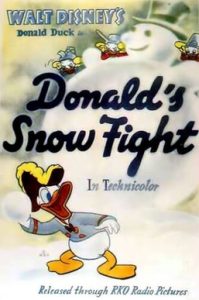 Donald’s Snow Fight (Disney/RKO, Donald Duck, 4/10/42 – Jack King, dir.) – An epic study of the fine art of snowball throwing. Morning breaks to reveal that a thick blanket of snow has covered the landscape surrounding Donald’s home. Donald peers out his door, only to have his beak turn ice blue. “I’d better get my overcoat”, he observes, but emerges game and ready to enjoy the winter season, in a coat that looks large enough to be covering seven layers of underclothing, but which it is revealed really offers little protection at all, as it widens inside like a bell, with Donald merely standing in the middle in his usual sailor suit, no warm fur gripping upon his body to hold in the heat. Donald drags along behind him a small sled, and climbs to the top of a hill where he gets a clear view of his nephews over the next knoll, constructing a king-size snowman. Cruelly, Donald remarks, “Here’s where I have some fun”, and zooms down the hill slope, straight into the snowman and the nephews too, leaving each one of them partially encased in the three snowballs which had made up the snowman’s body. The nephews huddle together to plot their typical revenge. Before Donald knows it, another snowman has been constructed – with an overly-long beak, a snowy sailor’s hat, and crossed eyes. “That’s Unca Donald!” shout the nephews in taunt to their uncle. Donald isn’t going to take this standing-up, and lies down upon the sled again, preparing for another charge. But that is just what the nephews want him to do, and he collides with the snowman at full speed – revealing a large boulder which the nephews used as the body for the snowman by merely covering it with a thin coating of snow. The vibration from the impact literally knocks every hair out of Donald’s fur coat (save one, which Donald plucks out himself to complete the job). Removing the now useless coat, Donald prepares for battle, while the nephews wisely retreat to a mammoth snow fort they have constructed along the banks of an ice pond. Much as a later Daffy Duck/Speedy Gonzales cartoon would insist on conducting a battle in “the grand manner”, Donald decides to match fortification with fortification – by constructing a snow battleship upon the surface of the ice lake.
Donald’s Snow Fight (Disney/RKO, Donald Duck, 4/10/42 – Jack King, dir.) – An epic study of the fine art of snowball throwing. Morning breaks to reveal that a thick blanket of snow has covered the landscape surrounding Donald’s home. Donald peers out his door, only to have his beak turn ice blue. “I’d better get my overcoat”, he observes, but emerges game and ready to enjoy the winter season, in a coat that looks large enough to be covering seven layers of underclothing, but which it is revealed really offers little protection at all, as it widens inside like a bell, with Donald merely standing in the middle in his usual sailor suit, no warm fur gripping upon his body to hold in the heat. Donald drags along behind him a small sled, and climbs to the top of a hill where he gets a clear view of his nephews over the next knoll, constructing a king-size snowman. Cruelly, Donald remarks, “Here’s where I have some fun”, and zooms down the hill slope, straight into the snowman and the nephews too, leaving each one of them partially encased in the three snowballs which had made up the snowman’s body. The nephews huddle together to plot their typical revenge. Before Donald knows it, another snowman has been constructed – with an overly-long beak, a snowy sailor’s hat, and crossed eyes. “That’s Unca Donald!” shout the nephews in taunt to their uncle. Donald isn’t going to take this standing-up, and lies down upon the sled again, preparing for another charge. But that is just what the nephews want him to do, and he collides with the snowman at full speed – revealing a large boulder which the nephews used as the body for the snowman by merely covering it with a thin coating of snow. The vibration from the impact literally knocks every hair out of Donald’s fur coat (save one, which Donald plucks out himself to complete the job). Removing the now useless coat, Donald prepares for battle, while the nephews wisely retreat to a mammoth snow fort they have constructed along the banks of an ice pond. Much as a later Daffy Duck/Speedy Gonzales cartoon would insist on conducting a battle in “the grand manner”, Donald decides to match fortification with fortification – by constructing a snow battleship upon the surface of the ice lake.
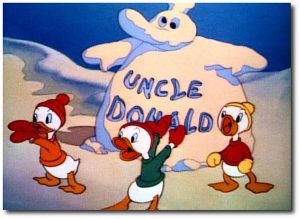 From its command deck, Donald launches his first salvo at the nephews, who taunt him from the turrets of their fort. Launching two consecutive snowballs, Donald splits one in half with the impact of another, causing the halves of the split snowball to travel sideways within the turret, accomplishing flanking hits upon two of the nephews hidden behind the ramparts. In similar fashion, he scores a hit upon the third nephew, causing them to roll around the icy platform of the fort in the accumulated snow, until the nephews appear to be three white bowling pins. Poking finger and thumb holes into a larger snowball, Donald launches an underhand throw, scoring a strike on the nephews and mowing them down. “They ain’t seen nothin’ yet. I’ll give ‘em ‘Big Bertha’”, boasts Donald to the audience. Fashioning snow into the shape of an artillery shell, Donald dips his creation into a bucket of water, then pulls it out, allowing the cold air to freeze the fluid into a surface of rigid ice. Using a snow shovel with its handle placed upon a fulcrum, Donald places his weapon on the shovel blade, then jumps on the handle, catapulting the shell high into the air. It comes down directly on the tip of the flagpole in the center of the nephews’ fort, splitting the wooden pole into three long segments, each of which bends over and pins to the ice floor a nephew. The vibrating wood providing a spanking to each of their rear ends. “Do you surrender?”, calls Donald. “NO!!” shout the nephews in unison, adding “We’ve not even begun to fight.” While Donald puzzles about what thy might be up to, the kids go into mass production, producing their own screw-apart two-piece snow artillery shells, each with a hollow area inside, into which they place a mousetrap. The bombs are loaded into a picnic basket, then the basket is launched with a wooden catapult to sail over Donald’s ship. A rope remains tied to the lid of the inverted basket, and at a signal, the other end of the rope is pilled by the nephews, opening the lid like a bomb bay door to drop the shells upon Donald. Several shells score direct hits, leaving Donald’s limbs and beak caught in mousetraps. The nephews begin a barrage of smaller snowballs, propelled from their turrets by means of crossbow mounted to a plank. The snowballs begin taking out the defensive shields around the deck of Donald’s ship, and one hits Donald’s commander’s hat, spinning it off like a threaded bottle lid, and leaving his head feathers in a spiral braid. “That’s unconstitutional!” retorts Donald. Donald takes refuge in the command bridge of his ship. Singing a few bars of “Battle Hymn of the Republic”, the nephews resort to their most powerful weapon – a small stone-lined hearth placed in the middle of their fort, where they have lit to red and white hotness several large lumps of coal. Spearing the coal lumps on arrow shafts and launching them with the crossbow, the nephews take careful aim at the bridge of Donald’s ship. Several flaming arrows hit the mark, poking melted holes in the bridge wall until the withering snow transforms the bridge into the image of a large skeleton skull. Donald emerges from hiding, still claiming he’ll exterminate the boys, but a large white-hot coal on another arrow lands below him, plunging into the heart of the ship’s hull. Everything begins to soften, as the heat takes its toll upon the vessel. Donald’s ship literally melts out from under him, plunging him into the ice-cold lake. The resulting splash sends Donald upwards out of the lake water in a rising wave, where he and the ejected water freeze as an ice statue on the spot. The nephews perform an Indian war dance of victory around the base of the statue, as the iris out occurs.
From its command deck, Donald launches his first salvo at the nephews, who taunt him from the turrets of their fort. Launching two consecutive snowballs, Donald splits one in half with the impact of another, causing the halves of the split snowball to travel sideways within the turret, accomplishing flanking hits upon two of the nephews hidden behind the ramparts. In similar fashion, he scores a hit upon the third nephew, causing them to roll around the icy platform of the fort in the accumulated snow, until the nephews appear to be three white bowling pins. Poking finger and thumb holes into a larger snowball, Donald launches an underhand throw, scoring a strike on the nephews and mowing them down. “They ain’t seen nothin’ yet. I’ll give ‘em ‘Big Bertha’”, boasts Donald to the audience. Fashioning snow into the shape of an artillery shell, Donald dips his creation into a bucket of water, then pulls it out, allowing the cold air to freeze the fluid into a surface of rigid ice. Using a snow shovel with its handle placed upon a fulcrum, Donald places his weapon on the shovel blade, then jumps on the handle, catapulting the shell high into the air. It comes down directly on the tip of the flagpole in the center of the nephews’ fort, splitting the wooden pole into three long segments, each of which bends over and pins to the ice floor a nephew. The vibrating wood providing a spanking to each of their rear ends. “Do you surrender?”, calls Donald. “NO!!” shout the nephews in unison, adding “We’ve not even begun to fight.” While Donald puzzles about what thy might be up to, the kids go into mass production, producing their own screw-apart two-piece snow artillery shells, each with a hollow area inside, into which they place a mousetrap. The bombs are loaded into a picnic basket, then the basket is launched with a wooden catapult to sail over Donald’s ship. A rope remains tied to the lid of the inverted basket, and at a signal, the other end of the rope is pilled by the nephews, opening the lid like a bomb bay door to drop the shells upon Donald. Several shells score direct hits, leaving Donald’s limbs and beak caught in mousetraps. The nephews begin a barrage of smaller snowballs, propelled from their turrets by means of crossbow mounted to a plank. The snowballs begin taking out the defensive shields around the deck of Donald’s ship, and one hits Donald’s commander’s hat, spinning it off like a threaded bottle lid, and leaving his head feathers in a spiral braid. “That’s unconstitutional!” retorts Donald. Donald takes refuge in the command bridge of his ship. Singing a few bars of “Battle Hymn of the Republic”, the nephews resort to their most powerful weapon – a small stone-lined hearth placed in the middle of their fort, where they have lit to red and white hotness several large lumps of coal. Spearing the coal lumps on arrow shafts and launching them with the crossbow, the nephews take careful aim at the bridge of Donald’s ship. Several flaming arrows hit the mark, poking melted holes in the bridge wall until the withering snow transforms the bridge into the image of a large skeleton skull. Donald emerges from hiding, still claiming he’ll exterminate the boys, but a large white-hot coal on another arrow lands below him, plunging into the heart of the ship’s hull. Everything begins to soften, as the heat takes its toll upon the vessel. Donald’s ship literally melts out from under him, plunging him into the ice-cold lake. The resulting splash sends Donald upwards out of the lake water in a rising wave, where he and the ejected water freeze as an ice statue on the spot. The nephews perform an Indian war dance of victory around the base of the statue, as the iris out occurs.
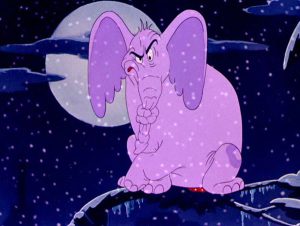 Horton Hatches the Egg (Warner, Merrie Melodies, 4/11/42 – Robert Clampett, dir.) – The gestation period of Maisie’s egg in the famous Dr. Seuss story is fifty-one weeks – allowing for a lot of seasonal changes. Hortin the elephant foolishly volunteers to egg-sit for Maisie, while Maisie takes what she classifies as a short needed rest – packing her traveling bags and disappearing to Palm Beach, with no intention of ever coming back. The first night, a torrential rainstorm hits the jungle. Not only is Horton dripping wet, but the jungle becomes completely flooded, submerging Horton below the rising water, leaving only the tip of his trunk above the water’s surface to talk to the audience. The Winter comes, and Horton endures icicles hanging from his ears and trunk – and a full-blown head cold. Even the egg lets out with a sneeze, to which Horton responds, “Gesundheit.” Horton tries his vest to hold in his sneezes, but finally finds the only sure-fire way is to tie a knot in his trunk. Eventually, the spring comes, and as the famous story goes, Horton is captured by transporting the nest and the entire tree aboard ship, and sold to a circus, which plays Palm Beach. Maisie tries to reclaim the egg now that the work is all done when she discovers Horton and hears the egg hatching – but Horton receives his just reward for his faithful service, as the hatchling has by sheer osmosis developed into the world’s first flying elephant-bird. (Take that, Dumbo.)
Horton Hatches the Egg (Warner, Merrie Melodies, 4/11/42 – Robert Clampett, dir.) – The gestation period of Maisie’s egg in the famous Dr. Seuss story is fifty-one weeks – allowing for a lot of seasonal changes. Hortin the elephant foolishly volunteers to egg-sit for Maisie, while Maisie takes what she classifies as a short needed rest – packing her traveling bags and disappearing to Palm Beach, with no intention of ever coming back. The first night, a torrential rainstorm hits the jungle. Not only is Horton dripping wet, but the jungle becomes completely flooded, submerging Horton below the rising water, leaving only the tip of his trunk above the water’s surface to talk to the audience. The Winter comes, and Horton endures icicles hanging from his ears and trunk – and a full-blown head cold. Even the egg lets out with a sneeze, to which Horton responds, “Gesundheit.” Horton tries his vest to hold in his sneezes, but finally finds the only sure-fire way is to tie a knot in his trunk. Eventually, the spring comes, and as the famous story goes, Horton is captured by transporting the nest and the entire tree aboard ship, and sold to a circus, which plays Palm Beach. Maisie tries to reclaim the egg now that the work is all done when she discovers Horton and hears the egg hatching – but Horton receives his just reward for his faithful service, as the hatchling has by sheer osmosis developed into the world’s first flying elephant-bird. (Take that, Dumbo.)
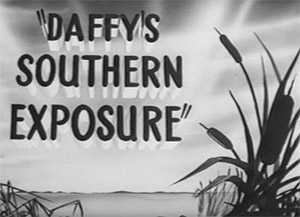 Daffy’s Southern Exposure (Warner, Daffy Duck, 5/2/42 – Norman McCabe, dir.) – This film begins looking like an almost identical remake of Woody Woodpecker’s “Pantry Panic”, with Daffy refusing to fly South for the winter, instead intent on finding out about ice carnivals, and having the whole pond to himself. “You’ll be sorry”, jeer the other dicks in unison. Daffy demonstrates his diving technique, but by the time he comes down, the pond has frozen over. Converting to skating moves, Daffy sings, “Snow fly don’t bother me.” As in Woody’s episode, intertitles announce the worsening of the weather, while the background transforms to a thick blanket of snow. “Thru wind and snow, at thirty below, we find our hero.” The camera pans around a background, depicting no action except for wind-driven snow. A new title appears on screen. “Gosh, we can’t find our hero!!” The snow worsens, nearly obliterating the screen, as we hear the agonized voice of Daffy crying out in the wilderness for food and sustenance. Suddenly, Daffy rips open an iris hole in the weather front, peering out at us to say. “What are you laughing at? I’m really hungry.” As the view clears somewhat, Daffy goes into seeing mirages from hunger. He embraces what appears to be a giant steak rising several stories out of the ground, only to find it is just a snow-covered tree. Frustrated, he rips two strips of bark off the tree trunk, then places them around one of his own hands. “Umm…Hand sandwich” Not very nourishing, when he gives himself a painful bite. From nowhere, an aroma trail wafts Into view, tempting his nostrils. “Is it really food?” he shouts. The trail changes shape, twisting into cursive letters reading “Yeah, food.” The trail leads to a remote log cabin, where a wolf and a weasel reside together. They are well stocked with provisions for the winter – but unfortunately, such supply consists entirely of canned beans. They can’t stand the same thing day in, day out, and the wolf wishes for a meal of roast duck, longing to experience again “that fowl taste in my mouth.” A knock at the door by the famished Daffy supplies the miracle. The two carnivores don disguises of little old ladies, and invite Daffy in. The weasel covers a wall sign reading “Never give a sucker an even break”, by turning it to the wall, revealing on the other side a sampler reading “Home Sweet Home.” The wolf provides Daffy with a hearty helping of beans, fattening him up. The, the disguises are cast away, and knives and cleavers appear instead. Daffy attempts to convince them he’s not a duck, doing his best impersonations of a pigeon and then a hummingbird. He zips out the cabin door, the wolf following, while the weasel opens the door the wrong way, bashing himself unconscious upon the wall. The wolf chops away at Daffy up and down a hollow tree, chopping the tree into a totem pole. Daffy dodges capture by making a funny face and posing as one off the totems. Finally, Daffy runs across a canyon via a log bridge, pulling a branch on the log like a railroad switch to sidetrack the wolf off the side of the log. Daffy never stops running, passing direction signs on the road pointing South…“And we do mean South.” He winds up in Brazil, where he is found in the tutti-fruity hat of a performing Carmen Miranda look-alike, commenting that he likes the South American Way.
Daffy’s Southern Exposure (Warner, Daffy Duck, 5/2/42 – Norman McCabe, dir.) – This film begins looking like an almost identical remake of Woody Woodpecker’s “Pantry Panic”, with Daffy refusing to fly South for the winter, instead intent on finding out about ice carnivals, and having the whole pond to himself. “You’ll be sorry”, jeer the other dicks in unison. Daffy demonstrates his diving technique, but by the time he comes down, the pond has frozen over. Converting to skating moves, Daffy sings, “Snow fly don’t bother me.” As in Woody’s episode, intertitles announce the worsening of the weather, while the background transforms to a thick blanket of snow. “Thru wind and snow, at thirty below, we find our hero.” The camera pans around a background, depicting no action except for wind-driven snow. A new title appears on screen. “Gosh, we can’t find our hero!!” The snow worsens, nearly obliterating the screen, as we hear the agonized voice of Daffy crying out in the wilderness for food and sustenance. Suddenly, Daffy rips open an iris hole in the weather front, peering out at us to say. “What are you laughing at? I’m really hungry.” As the view clears somewhat, Daffy goes into seeing mirages from hunger. He embraces what appears to be a giant steak rising several stories out of the ground, only to find it is just a snow-covered tree. Frustrated, he rips two strips of bark off the tree trunk, then places them around one of his own hands. “Umm…Hand sandwich” Not very nourishing, when he gives himself a painful bite. From nowhere, an aroma trail wafts Into view, tempting his nostrils. “Is it really food?” he shouts. The trail changes shape, twisting into cursive letters reading “Yeah, food.” The trail leads to a remote log cabin, where a wolf and a weasel reside together. They are well stocked with provisions for the winter – but unfortunately, such supply consists entirely of canned beans. They can’t stand the same thing day in, day out, and the wolf wishes for a meal of roast duck, longing to experience again “that fowl taste in my mouth.” A knock at the door by the famished Daffy supplies the miracle. The two carnivores don disguises of little old ladies, and invite Daffy in. The weasel covers a wall sign reading “Never give a sucker an even break”, by turning it to the wall, revealing on the other side a sampler reading “Home Sweet Home.” The wolf provides Daffy with a hearty helping of beans, fattening him up. The, the disguises are cast away, and knives and cleavers appear instead. Daffy attempts to convince them he’s not a duck, doing his best impersonations of a pigeon and then a hummingbird. He zips out the cabin door, the wolf following, while the weasel opens the door the wrong way, bashing himself unconscious upon the wall. The wolf chops away at Daffy up and down a hollow tree, chopping the tree into a totem pole. Daffy dodges capture by making a funny face and posing as one off the totems. Finally, Daffy runs across a canyon via a log bridge, pulling a branch on the log like a railroad switch to sidetrack the wolf off the side of the log. Daffy never stops running, passing direction signs on the road pointing South…“And we do mean South.” He winds up in Brazil, where he is found in the tutti-fruity hat of a performing Carmen Miranda look-alike, commenting that he likes the South American Way.
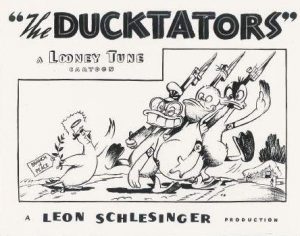 The Ducktators (Warner, Looney Tunes, 8/1/42 – Norman McCabe. dir.) – A dated wartime cartoon heavy on stereotypes, with Hitler, Mussolini and Hirohito all portrayed as ducks dictating to the barnyard populace. It receives nearly-honorable mention for a gag displaying Der Fuerher’s “storm troopers” – an elite unit of ducks, who only march in pouring rain, are largely unable to see due to their heads being buried in a cover of clouds that travel along with them as they march, and spend much of their time dodging lightning strikes to their rear-ends. Long known only in edited versions for early television missing its “War Bonds” ending, the film was finally restored to its original running length for one of the Looney Tunes multi-disc DVD boxes.
The Ducktators (Warner, Looney Tunes, 8/1/42 – Norman McCabe. dir.) – A dated wartime cartoon heavy on stereotypes, with Hitler, Mussolini and Hirohito all portrayed as ducks dictating to the barnyard populace. It receives nearly-honorable mention for a gag displaying Der Fuerher’s “storm troopers” – an elite unit of ducks, who only march in pouring rain, are largely unable to see due to their heads being buried in a cover of clouds that travel along with them as they march, and spend much of their time dodging lightning strikes to their rear-ends. Long known only in edited versions for early television missing its “War Bonds” ending, the film was finally restored to its original running length for one of the Looney Tunes multi-disc DVD boxes.
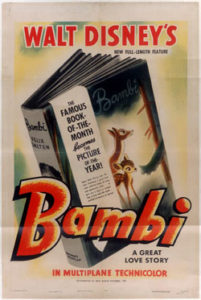 Bambi (Disney/RKO, 8/13/43) – Disney’s ultimate nature study features a memorable sequence and tune, “Little April Shower”, depicting all the detail of a rainstorm in the forest (save flooding) with naturalistic realism, as well as a few added elements of fancy. Bambi and his mother bed down for the night. Bambi is just beginning to doze, when he is awakened to alertness by a raindrop hitting his nose. This is his first experience with rain, and his expression is handled wonderfully by the animators, utilizing the positioning of his alert ears as a means of emphasizing surprise and wonderment, as a parade of the small raindrops begins trickling down each leaf and stem in the thicket. The multiplane camera is also used to great advantage, dimensionally pulling us back from Bambi’s resting place into the larger woods, where various birds, ducks, and wise old Owl react in different ways to the oncoming storm. A mama bird hurries her brood to huddle under her within the safety of a nest one of her fledglings peeping out amidst her tail feathers, only to take a direct hit from one of the raindrops. The ducks aren’t phased at all, even getting wetter by taking to the pond for a swim. Owl reacts in moves that seem to be closely parallel to the owl in “The Old Mill”, a bit ruffled by this regular inconvenience which he’s seen too often before, and turning his back to the whole affair. Then comes the even bigger surprise, as lightning begins flashing wildly across the sky. Bambi reacts in instinctive fear, trying his best to hide himself under his mother as each bolt crashes with the sound of a cymbal, and the entire scene is lit in relief from glaring white light above. Choral and orchestral work throughout this portion of the number is amazingly well performed with precision and emotion. Finally, the fall of water slows, the clouds subside, and the first rays of golden sunshine begin to peep through above. Although daylight is breaking, after a night like that, Bambi and his mom decide to sleep in, getting a little well-needed rest. The camera pulls back, again by way of multiplane, featuring a beautiful effect of deliberate photographic blurring of images in the forefront, so that we appear to be peering past some of the last remaining raindrops falling close to us and slightly out of our focal range. The view pans down to the pond, as the last notes of the song accompany the final falling raindrops, against the water’s reflection of the orange sky above. And the last two raindrops fall placidly into the water, leaving rippling trails, and the forest at peace.
Bambi (Disney/RKO, 8/13/43) – Disney’s ultimate nature study features a memorable sequence and tune, “Little April Shower”, depicting all the detail of a rainstorm in the forest (save flooding) with naturalistic realism, as well as a few added elements of fancy. Bambi and his mother bed down for the night. Bambi is just beginning to doze, when he is awakened to alertness by a raindrop hitting his nose. This is his first experience with rain, and his expression is handled wonderfully by the animators, utilizing the positioning of his alert ears as a means of emphasizing surprise and wonderment, as a parade of the small raindrops begins trickling down each leaf and stem in the thicket. The multiplane camera is also used to great advantage, dimensionally pulling us back from Bambi’s resting place into the larger woods, where various birds, ducks, and wise old Owl react in different ways to the oncoming storm. A mama bird hurries her brood to huddle under her within the safety of a nest one of her fledglings peeping out amidst her tail feathers, only to take a direct hit from one of the raindrops. The ducks aren’t phased at all, even getting wetter by taking to the pond for a swim. Owl reacts in moves that seem to be closely parallel to the owl in “The Old Mill”, a bit ruffled by this regular inconvenience which he’s seen too often before, and turning his back to the whole affair. Then comes the even bigger surprise, as lightning begins flashing wildly across the sky. Bambi reacts in instinctive fear, trying his best to hide himself under his mother as each bolt crashes with the sound of a cymbal, and the entire scene is lit in relief from glaring white light above. Choral and orchestral work throughout this portion of the number is amazingly well performed with precision and emotion. Finally, the fall of water slows, the clouds subside, and the first rays of golden sunshine begin to peep through above. Although daylight is breaking, after a night like that, Bambi and his mom decide to sleep in, getting a little well-needed rest. The camera pulls back, again by way of multiplane, featuring a beautiful effect of deliberate photographic blurring of images in the forefront, so that we appear to be peering past some of the last remaining raindrops falling close to us and slightly out of our focal range. The view pans down to the pond, as the last notes of the song accompany the final falling raindrops, against the water’s reflection of the orange sky above. And the last two raindrops fall placidly into the water, leaving rippling trails, and the forest at peace.
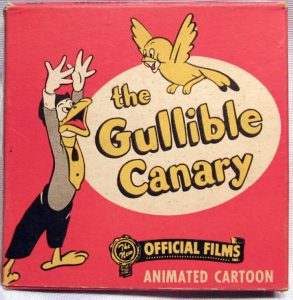 The Gullible Canary (Columbia/Screen Gems, Phantasy, 9/18/42 – Alex Geiss, dir.) – A hobo crow complains at how life is tough for a bird in the wild, and gripes at how migration is wearing him down. He passes a window, from which he hears the sound of happy chirping inside a bird cage. “What’s he got to be happy about?” Grumbles the crow – then repeats the same line as a genuine question to himself, realizing that the canary inside this cage has food, water, a bath and “a place to flop”. What a setup! Quickly devising a scheme, the crow begins weeping at the canary’s window. When the canary inquires what’s the matter, the crow states his heart is breaking to see someone so young “in the clink”. He begs for the chance to help the canary escape his “incarceration”, and tells him of the freedoms of the outside world, the ability to go where you please, and even to find love – perchance with some gorgeous Southern belle. Producing a handy set of keys, the crow quickly manipulates the lock of the cage, setting the canary free. “Fly, fly”, he encourages. The canary shakes his hand, stating he’ll never forget the crow’s kind deed, and sets out to see the world – while the crow dashes into the cage, settling down in the canary’s easy chair and putting his feet up, ready to snooze away the winter in total comfort.
The Gullible Canary (Columbia/Screen Gems, Phantasy, 9/18/42 – Alex Geiss, dir.) – A hobo crow complains at how life is tough for a bird in the wild, and gripes at how migration is wearing him down. He passes a window, from which he hears the sound of happy chirping inside a bird cage. “What’s he got to be happy about?” Grumbles the crow – then repeats the same line as a genuine question to himself, realizing that the canary inside this cage has food, water, a bath and “a place to flop”. What a setup! Quickly devising a scheme, the crow begins weeping at the canary’s window. When the canary inquires what’s the matter, the crow states his heart is breaking to see someone so young “in the clink”. He begs for the chance to help the canary escape his “incarceration”, and tells him of the freedoms of the outside world, the ability to go where you please, and even to find love – perchance with some gorgeous Southern belle. Producing a handy set of keys, the crow quickly manipulates the lock of the cage, setting the canary free. “Fly, fly”, he encourages. The canary shakes his hand, stating he’ll never forget the crow’s kind deed, and sets out to see the world – while the crow dashes into the cage, settling down in the canary’s easy chair and putting his feet up, ready to snooze away the winter in total comfort.
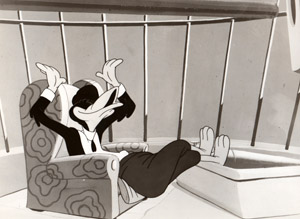 The canary runs the gamut of hard luck from the moment he begins his journey. He suddenly hears his voice echo as if in a cave, and finds the view darkening around him, as he discovers that a hawk has slipped up upon him in mid-flight, with jaws wide open, leaving the canary half-way to the destination of down his throat. It takes some fancy flying, but the canary lures the hawk into a cloudbank, which conceals a mountain peak, leaving the hawk unconscious from a crash into the cliffside. The canary takes refuge in a steeple clock bell tower, just as it chimes 12 noon. The swinging clappers nearly smash him, and he falls out of the tower in a zig-zag path matching the swinging of the bells, with his head ringing long afterwards. No sooner is he on the ground, than a cat pounces upon him, nipping off several of his tail feathers. He joins up with a flight of honking geese – only to find they’ve ventured over a marshland, loaded to the teeth with hunters and their rifles. All of the flock save the canary fall in the crossfire, and the canary almost gets it in the end when he makes a landing right in the barrel of one of the rifles. Finally, the weather takes a turn for the worst. Snow flurries whisk across the skies, and our canary appears as nothing but a snowball with head and wings protruding. He shakes off the snow, only to find his wings becoming completely coated with ice. Unable to flap them, he freezes solid, and plummets from the sky. At long last, his luck changes, as he lands on something soft – a coating of snow, atop the caboose of a moving train. As the train rounds a curve and disappears down the track in a perspective shot away from the camera, we see a sign on the rear of the train reading “Miami Limited.”
The canary runs the gamut of hard luck from the moment he begins his journey. He suddenly hears his voice echo as if in a cave, and finds the view darkening around him, as he discovers that a hawk has slipped up upon him in mid-flight, with jaws wide open, leaving the canary half-way to the destination of down his throat. It takes some fancy flying, but the canary lures the hawk into a cloudbank, which conceals a mountain peak, leaving the hawk unconscious from a crash into the cliffside. The canary takes refuge in a steeple clock bell tower, just as it chimes 12 noon. The swinging clappers nearly smash him, and he falls out of the tower in a zig-zag path matching the swinging of the bells, with his head ringing long afterwards. No sooner is he on the ground, than a cat pounces upon him, nipping off several of his tail feathers. He joins up with a flight of honking geese – only to find they’ve ventured over a marshland, loaded to the teeth with hunters and their rifles. All of the flock save the canary fall in the crossfire, and the canary almost gets it in the end when he makes a landing right in the barrel of one of the rifles. Finally, the weather takes a turn for the worst. Snow flurries whisk across the skies, and our canary appears as nothing but a snowball with head and wings protruding. He shakes off the snow, only to find his wings becoming completely coated with ice. Unable to flap them, he freezes solid, and plummets from the sky. At long last, his luck changes, as he lands on something soft – a coating of snow, atop the caboose of a moving train. As the train rounds a curve and disappears down the track in a perspective shot away from the camera, we see a sign on the rear of the train reading “Miami Limited.”
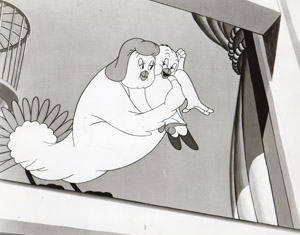 Spring comes, and we return to the canary’s former abode, now well lived-in by the crow, who has pit in quite a bit of wear and tear through abusive use of the furnishings. “Hello” calls a voice. To the crow’s surprise, it is the canary. Breaking up with laughter from knowing what to expect, the crow sadistically asks if the canary had a good time. The canary answers truthfully, but with no outward sign of malice, that he did not, and tells of his misfortunes including the incidents with the hawk, cat, and snowstorm. Continuing to break himself up with laughter, the hawk asks if he met one of those Southern belles. To his surprise, the canary answers yes, and informs him that he got married, and his bride is right here. Still laughing, the crow asks where he and the missus are living. Suddenly, his jaw drops, and the laughter stops, as the missus appears at the window – a muscular she-bird, four times bigger than the canary, and twice the size of the crow. Without answering the crow’s question immediately, the canary informs his wife. “This is the bird I was talking to you about.” Brushing back the feathers on her brawny arms as if rolling up her sleeve, the wife displays a fierce scowl on her face, and dives into the cage, where she and the crow vanish from view inside a fight cloud. “I can take a hint. I was just leavin’”, yells the crow between blows, and winds up tossed out the window on his ear, his bindle stick thrown out after him. “We’re staying right here”, finally answers the canary with a satisfied smile, as his wife embraces him, adding “We most surely are, honey chile.”
Spring comes, and we return to the canary’s former abode, now well lived-in by the crow, who has pit in quite a bit of wear and tear through abusive use of the furnishings. “Hello” calls a voice. To the crow’s surprise, it is the canary. Breaking up with laughter from knowing what to expect, the crow sadistically asks if the canary had a good time. The canary answers truthfully, but with no outward sign of malice, that he did not, and tells of his misfortunes including the incidents with the hawk, cat, and snowstorm. Continuing to break himself up with laughter, the hawk asks if he met one of those Southern belles. To his surprise, the canary answers yes, and informs him that he got married, and his bride is right here. Still laughing, the crow asks where he and the missus are living. Suddenly, his jaw drops, and the laughter stops, as the missus appears at the window – a muscular she-bird, four times bigger than the canary, and twice the size of the crow. Without answering the crow’s question immediately, the canary informs his wife. “This is the bird I was talking to you about.” Brushing back the feathers on her brawny arms as if rolling up her sleeve, the wife displays a fierce scowl on her face, and dives into the cage, where she and the crow vanish from view inside a fight cloud. “I can take a hint. I was just leavin’”, yells the crow between blows, and winds up tossed out the window on his ear, his bindle stick thrown out after him. “We’re staying right here”, finally answers the canary with a satisfied smile, as his wife embraces him, adding “We most surely are, honey chile.”
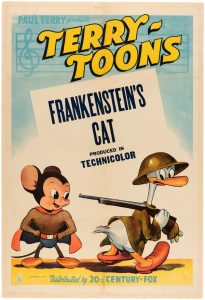 Frankenstein’s Cat (Terrytoons/Fox, Super Mouse, 11/27/42 – Mannie Davis, dir.) – The second cartoon to feature the little rodent who lived in a “Super” Market, who with the aid of its products could transform into “The Mouse of Tomorrow” – who we would later know as Mighty Mouse. He had a long way to develop. First, his color scheme was not yet set, his outfit being a mere imitation of the traditional colors of Superman. Next, he had not yet found his proper voice. This is the first cartoon of the series (and the only one, for a while), in which he would be given a few lines of dialogue. In an odd choice, he is given a “little tough guy” voice in falsetto with Brooklyn accent – a persona which would never again be returned to.
Frankenstein’s Cat (Terrytoons/Fox, Super Mouse, 11/27/42 – Mannie Davis, dir.) – The second cartoon to feature the little rodent who lived in a “Super” Market, who with the aid of its products could transform into “The Mouse of Tomorrow” – who we would later know as Mighty Mouse. He had a long way to develop. First, his color scheme was not yet set, his outfit being a mere imitation of the traditional colors of Superman. Next, he had not yet found his proper voice. This is the first cartoon of the series (and the only one, for a while), in which he would be given a few lines of dialogue. In an odd choice, he is given a “little tough guy” voice in falsetto with Brooklyn accent – a persona which would never again be returned to.
The scene opens on a peaceful midsummer day, with mice and birds frolicking in the woods. A freak whirlwind catches a baby bord just learning to fly in an updraft, spinning him around and around across the sky, until he is wafted to the eights of an old castle, amidst skies that seem to be permanently dark and stormy as if in their own micro-climate. He is deposited by the winds onto the end of a gargoyle waterspout shaped like a raven’s neck, and remains stranded there, fearful as to how to get down. A narrator asks the question, “What fiend of darkness haunts this place? It’s Frankenstein’s Cat!” Our title villain enters across the castle roof, amidst ramparts and parapets. He is built of metal, with a torso built from a cylindrical boiler, a tail made of metal balls wired together, stove-pope limbs, and feet resembling flat irons. His head, which is one of the few parts resembling something alive, has an upper lip line that looks like a row of surgical stitches. Moving in lumbering mechanical fashion, the monster pauses briefly upon a castle tower to receive a recharge of energy for the day, from the ever-present lightning bolts in the sky from which he undoubtedly received his life spark. Glowing briefly with the internal radiance of his renewed power, he wanders to the edge of the castle wall for a look around, and spots the stranded bird. His eyes roll in opposite directions, fascinated with the tasty treat. Crouching low behind the wall, he leaps over the top in a lunge for the bird. One look at the monster is enough to give the bird courage to make the jump, and he disappears out of camera frame toward the ground below. The cat also disappears, but in helpless free fall toward the ground many stories below. Landing in a heap, bit unharmed, he shakes his fist defiantly at the bird in an “I’ll get you” gesture, then resorts to an old stand-by which had appeared in several precious Terrytoons – an at-the-ready mechanical kicking machine on the grounds of the castle, where he pulls a lever repeatedly to cause a mechanical boot to kick himself in the rear for his initial failure to capture his prey.
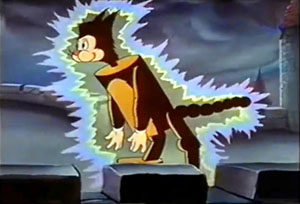 The monster goes on a rampage, entering the village of the birds and mice, and knocking down bird houses and uprooting trees in search of the tender bird. He spots the bird through the hole of one of the bird houses, and displays a hidden power made possible by the lightning stored within him – an electric finger which, when pointed at an object or animal, emits a powerful zap of energy – in this instance sufficient to burn the birdhouse to a crisp, revealing the bird hiding in a bathtub within the premises. Eventually, the cat captures the bird, and tramps back to the castle, shooing away a flock of other circling birds and mice who try to protest. He disappears up the castle drawbridge and into his fortifications. The mice and birds form an angry mob, complete with the traditional fiery torches, and converge at the castle moat to lay siege to the place. Several mice begin swimming across the moat, and begin to scale the castle wall. The cat tries to dissuade them, by hurling large slabs of rock off the castle roof, but his aim misses the mark of his intended victims every time. His marksmanship, however, is right on target with his electric finger, as he lies in wait at the edge of the castle roof, and zaps each mouse who climbs there, stunning them and causing them to fall into the moat.
The monster goes on a rampage, entering the village of the birds and mice, and knocking down bird houses and uprooting trees in search of the tender bird. He spots the bird through the hole of one of the bird houses, and displays a hidden power made possible by the lightning stored within him – an electric finger which, when pointed at an object or animal, emits a powerful zap of energy – in this instance sufficient to burn the birdhouse to a crisp, revealing the bird hiding in a bathtub within the premises. Eventually, the cat captures the bird, and tramps back to the castle, shooing away a flock of other circling birds and mice who try to protest. He disappears up the castle drawbridge and into his fortifications. The mice and birds form an angry mob, complete with the traditional fiery torches, and converge at the castle moat to lay siege to the place. Several mice begin swimming across the moat, and begin to scale the castle wall. The cat tries to dissuade them, by hurling large slabs of rock off the castle roof, but his aim misses the mark of his intended victims every time. His marksmanship, however, is right on target with his electric finger, as he lies in wait at the edge of the castle roof, and zaps each mouse who climbs there, stunning them and causing them to fall into the moat.
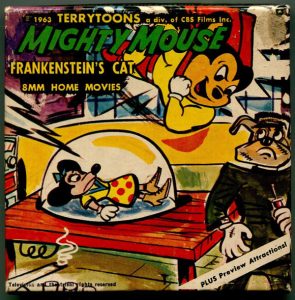 The assault on the castle thus gets nowhere, and a telephone call is placed by an unknown caller to the Super Market, requesting help to fight the monster. The scrawny mouse who is our hero dives into a wheel of super Limburger cheese (an inconsistency in the series, as Limburger would later prove a weakness to Mighty Mouse in an Oil Can Harry episode), eating his way through it in a circular path, and is transformed into Super Mouse. (No original prints of this cartoon have to date surfaced, so the audio track is doctored to replace the name with “Mighty Mouse”). Super flies into the phone receiver, traces the call through the phone wire, and is soon at the castle. He charges straight through the closed drawbridge, knocking it down. He battles off a nuisance flock of bats in the entrance, then produces from under his cape a sword. The surprised cat appears upon a spiral stairway leading up one of the castle’s towers, and also from nowhere produces a sword. The two duel their way up the stairs as if in a Musketeer epic, them the cat disappears into an internal room. Super follows, and after some rumblings of a fight within, there is a pause of silence. The camera dissolves to an internal view within the room, where we find Super in charge, with the cat bound by ropes to a large chair. Super begins to give the cat the “Third Degree”. “What did ya do with the boid? So you won’t talk?” Using x-ray vision (a power rarely displayed by Super), he spots the bird alive, inside the boiler body of the cat. Mustering all his strength, the cat breaks free of his bonds, and beats a retreat to a castle window. Calling upon his bats for transportation, he grabs two with his hands, and stands on the backs of two more, allowing himself to be lifted into the skies outside. Super follows, and after battling a jet of flame which the cat issues as a final assault weapon from his mouth, Super knocks the cat’s head off. The bird flies out the hole left where the cat’s neck once was, and Super carries him safely to his mother, and receives a hero’s welcome from the crowd.
The assault on the castle thus gets nowhere, and a telephone call is placed by an unknown caller to the Super Market, requesting help to fight the monster. The scrawny mouse who is our hero dives into a wheel of super Limburger cheese (an inconsistency in the series, as Limburger would later prove a weakness to Mighty Mouse in an Oil Can Harry episode), eating his way through it in a circular path, and is transformed into Super Mouse. (No original prints of this cartoon have to date surfaced, so the audio track is doctored to replace the name with “Mighty Mouse”). Super flies into the phone receiver, traces the call through the phone wire, and is soon at the castle. He charges straight through the closed drawbridge, knocking it down. He battles off a nuisance flock of bats in the entrance, then produces from under his cape a sword. The surprised cat appears upon a spiral stairway leading up one of the castle’s towers, and also from nowhere produces a sword. The two duel their way up the stairs as if in a Musketeer epic, them the cat disappears into an internal room. Super follows, and after some rumblings of a fight within, there is a pause of silence. The camera dissolves to an internal view within the room, where we find Super in charge, with the cat bound by ropes to a large chair. Super begins to give the cat the “Third Degree”. “What did ya do with the boid? So you won’t talk?” Using x-ray vision (a power rarely displayed by Super), he spots the bird alive, inside the boiler body of the cat. Mustering all his strength, the cat breaks free of his bonds, and beats a retreat to a castle window. Calling upon his bats for transportation, he grabs two with his hands, and stands on the backs of two more, allowing himself to be lifted into the skies outside. Super follows, and after battling a jet of flame which the cat issues as a final assault weapon from his mouth, Super knocks the cat’s head off. The bird flies out the hole left where the cat’s neck once was, and Super carries him safely to his mother, and receives a hero’s welcome from the crowd.
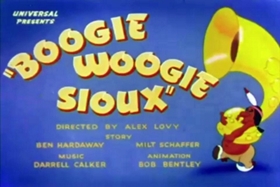 Boogie Woogie Sioux (Lantz/Universal, Swing Symphony, 11/30/42 – Alex Lovy dir,) – The plight of the Indian rainmaker is visited again, but this time with the aid of a boogie beat. At the reservation of Beetle Bow, Arizona (“where the sad meets its dune”), Chief Red Corpuscle reads headlines of continuing heat wave. A thermometer on the wall of the trading post rises to a reading of “What’s cookin’?” He marches to the abode of Silex-Drip, rainmaker (reference to Proctor-Silex make of coffee pot). “You make-um rain quick…or else”, the chief orders. “OK. Chief, I dood it”, responds Silex in impression of Red Skelton. Silex begins beating on a tom-rom, faster and faster, but not a drop. In the skies above, the sum scoffs with a sinister laugh, and blows a blast of heat down upon the land. A cactus is reduced to a small whistling tea kettle. A pumpkin becomes an instant pumpkin pie. The carcass of a dead cow, lying where it fell at the edge of a long-extinct water hole, raises its skeleton head to remark, “Boy, am I thirsty.” The land becomes so dry, it begins to crack in a long jagged line, pausing to also crack pottery resting in its path, and pursuing the Chief across the reservation (only rerouted when it ventures onto a railroad track, and the chief pulls a switch to send it onto a spur line). The chief has had enough, and gives Silex the boot off the land, landing him deep within a dry well. The chief then posts a sign at the roadside reading “Rainmaker wanted”. Down the road comes a motor scooter pulling a trailer full of band members, their drum identifying the aggregation as “Tommy Hawk and his 5 Scalpers”. They apply for the job, and all is saved with Tommy’s driving boogie-woogie drum beat. Rings of clouds surrounding distant mountain peaks are attracted by the music, and separate into anthropomorphic dancing Indian braves. Tommy beats from his drum a huge bolt of electrical energy, that rises into the sky like a lightning bolt, striking one of the dancing clouds in the rear end, and splitting it open to empty out a cloudburst. Actions from earlier in the film are reversed, and even the cow carcass drinks its fill (though the water seeps right out between its skeletal ribs). The land becomes well saturated, with most of the band floating or playing in large puddles and rivulets. The final shot closes in an iris out, with so much rain built up behind it, that it pours through the hole as a waterfall upon the audience, while the words “The End” appear above (a shot missing from many home movie editions).
Boogie Woogie Sioux (Lantz/Universal, Swing Symphony, 11/30/42 – Alex Lovy dir,) – The plight of the Indian rainmaker is visited again, but this time with the aid of a boogie beat. At the reservation of Beetle Bow, Arizona (“where the sad meets its dune”), Chief Red Corpuscle reads headlines of continuing heat wave. A thermometer on the wall of the trading post rises to a reading of “What’s cookin’?” He marches to the abode of Silex-Drip, rainmaker (reference to Proctor-Silex make of coffee pot). “You make-um rain quick…or else”, the chief orders. “OK. Chief, I dood it”, responds Silex in impression of Red Skelton. Silex begins beating on a tom-rom, faster and faster, but not a drop. In the skies above, the sum scoffs with a sinister laugh, and blows a blast of heat down upon the land. A cactus is reduced to a small whistling tea kettle. A pumpkin becomes an instant pumpkin pie. The carcass of a dead cow, lying where it fell at the edge of a long-extinct water hole, raises its skeleton head to remark, “Boy, am I thirsty.” The land becomes so dry, it begins to crack in a long jagged line, pausing to also crack pottery resting in its path, and pursuing the Chief across the reservation (only rerouted when it ventures onto a railroad track, and the chief pulls a switch to send it onto a spur line). The chief has had enough, and gives Silex the boot off the land, landing him deep within a dry well. The chief then posts a sign at the roadside reading “Rainmaker wanted”. Down the road comes a motor scooter pulling a trailer full of band members, their drum identifying the aggregation as “Tommy Hawk and his 5 Scalpers”. They apply for the job, and all is saved with Tommy’s driving boogie-woogie drum beat. Rings of clouds surrounding distant mountain peaks are attracted by the music, and separate into anthropomorphic dancing Indian braves. Tommy beats from his drum a huge bolt of electrical energy, that rises into the sky like a lightning bolt, striking one of the dancing clouds in the rear end, and splitting it open to empty out a cloudburst. Actions from earlier in the film are reversed, and even the cow carcass drinks its fill (though the water seeps right out between its skeletal ribs). The land becomes well saturated, with most of the band floating or playing in large puddles and rivulets. The final shot closes in an iris out, with so much rain built up behind it, that it pours through the hole as a waterfall upon the audience, while the words “The End” appear above (a shot missing from many home movie editions).
Another stormy spree, into ‘43, next time.


 Charles Gardner is an animation enthusiast who toils by day as a member of LA Law – but by nights and weekends indulges in classic jazz and ragtime as a performer; and studies classic Hollywood cartoons… maybe a little too much.
Charles Gardner is an animation enthusiast who toils by day as a member of LA Law – but by nights and weekends indulges in classic jazz and ragtime as a performer; and studies classic Hollywood cartoons… maybe a little too much.


































































































































































“Little April Shower” is perhaps overshadowed by some other scenes in “Bambi”, such as the hunt and the forest fire, but it’s a masterful tour de force of music and animation. Frank Churchill came up with the melody on the spot when Walt Disney asked him for something to convey the onset of rainfall. Then Edward Plumb crafted this melody into a grand composition akin to a Mahler symphony in miniature, in which a naively simple tune is developed into increasingly complex and dramatic textures, paralleling the progress of the storm. Finally the music comes full circle and ends as it began, proving that even the most violent rainstorm begins, and ends, with a single drop.
But while “Little April Shower” has a very simple-sounding melody, it is by no means an easy song to sing. Its lilting phrases, rapid pitter-patter lyrics and intricate counterpoint are enough to tax the skills of the most expert and disciplined chorus. Fortunately, Walt Disney had just such a chorus at his disposal, and they exemplify a standard of ensemble singing that is all too seldom heard today. “Beautiful sound! Beautiful sound!”
There’s also the charming character animation of Bambi himself and the other forest animals, the stunning imagery (I love the tiny hummingbird sheltering inside a Jack-in-the-pulpit) and some brilliant effects animation, with the raindrops transforming into sparks with each flash of lightning. A great song and a great sequence from a masterpiece of a film.
I took part in many snowball fights when I was growing up, and the boys in my neighbourhood had a sort of “Geneva Convention” agreement that certain things just weren’t allowed, including most of what Donald and his nephews get up to in their cartoon. Pouring water on snowballs to turn them into ice was a definite no-no, as was packing snow around rocks. (The issue of mousetraps never came up.) There were, however, some who went ahead and did it anyway, one boy in particular who once beaned me with a snowball that had a big chunk of asphalt in it. That kid grew up to become a police detective in Washington, D.C., and he wound up going to federal prison for felony extortion. That doesn’t have anything to do with anything in this post, of course. It just makes me feel really good to think about it!
Donald Duck is not a fit parent.
“Bambi” fails by succeeding. It’s so realistic that audiences can’t appreciate the animation; they don’t stop to think that someone actually drew all that. Also, as one of the animators later said, the middle of World War II was not the ideal time for a sweet little story about please don’t shoot the deer.
Yeah, I 100% disagree about that point on “Bambi”.
So… people would appreciate the animation more if it wasn’t as good? And war is no time for films about men with guns invading someone’s homeland and decimating the population?
I agree on Bambi. It has no plot; the center is his mother’s death, and the characters are “pretty” cardboard cutouts. Cowers before Dumbo the year before.
Boogie Woogie Sioux is the clear winner in this week’s weather report. I’d never seen this one before. Somebody needs to compile, restore and distribute the entire Swing Symphony series, like right now.
Darrell Calker shreds!
That Horton cartoon is one of my favorites. I saw it when I was real little, but I still remember the line “An elephant’s faithful 100 percent”. The world could use more Hortons.
I should mentioned that “Donald’s Snow Fight” was co-written by Carl Barks (with Harry Reeves) and it seemed to help form a basis for Bark’s comic stories he did with Donald and the nephews a few years later.
Horton Hatches The Egg not only exhibited Clampett’s comedic abilities, the film proved he could handle pathos. In my estimation, that’s the best animated adaptation of Seuss’s work.